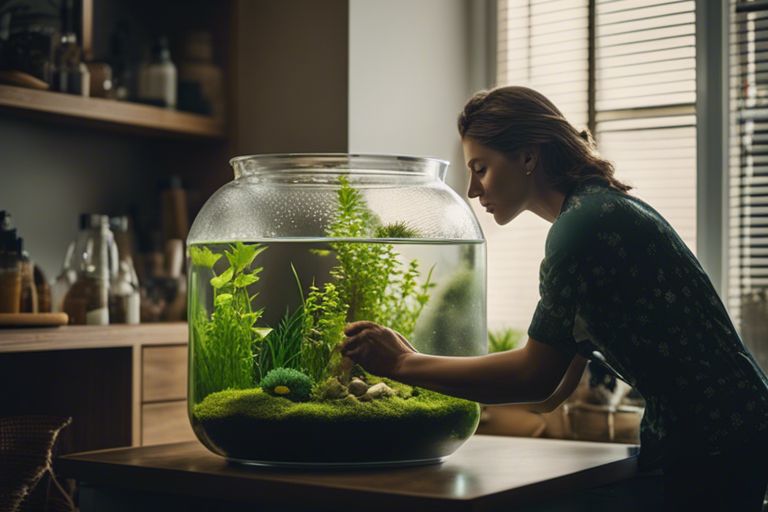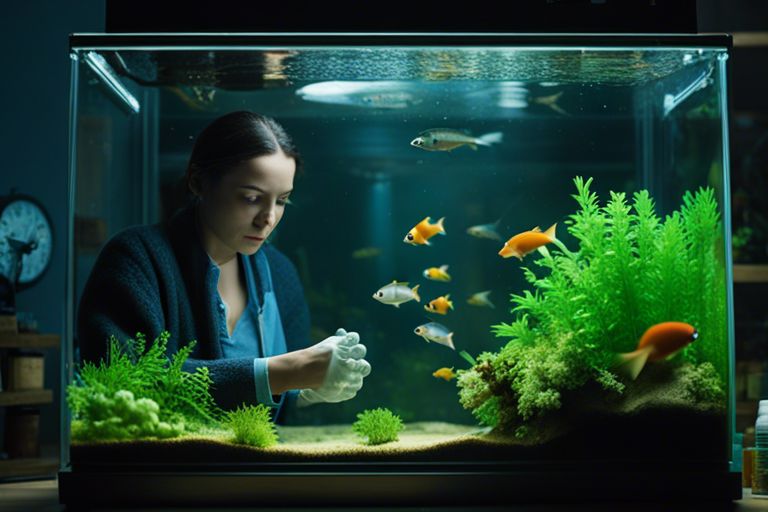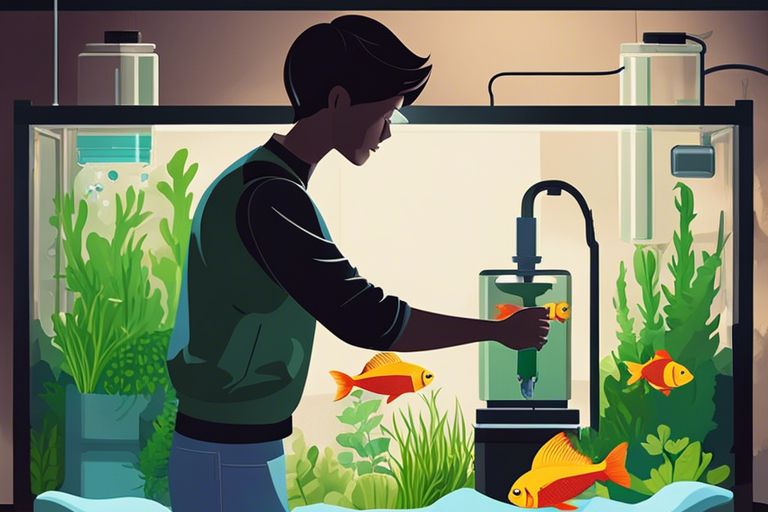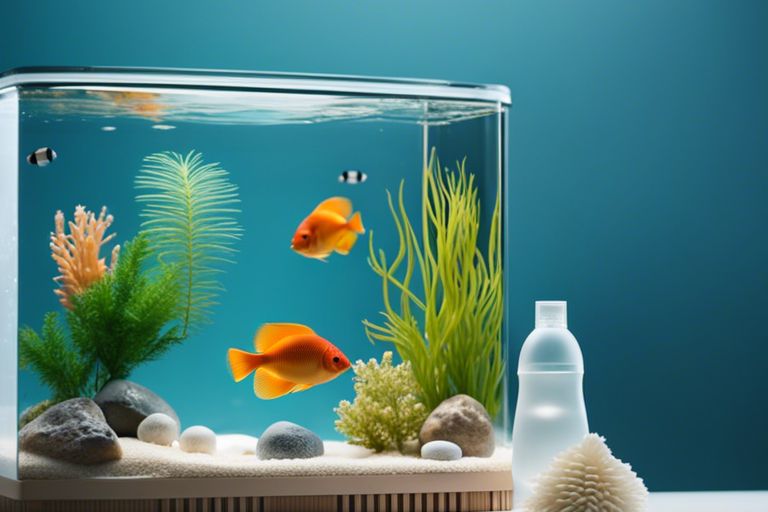Dealing with a dirty fish tank can be a frustrating and challenging task for any fish owner. However, maintaining a clean and healthy environment for your aquatic pets is crucial for their well-being. In this comprehensive troubleshooting guide, we will address common issues that lead to dirty fish tanks and provide practical solutions to help you get your tank back to optimal conditions. By following these expert tips and techniques, you can ensure a clean and thriving habitat for your beloved fish.

Types of Fish Tank Contaminants
For a clean and healthy fish tank environment, it is imperative to understand the different types of contaminants that can impact your aquatic ecosystem. Here is a breakdown of the most common types of fish tank pollutants:
| Biological Waste | Chemical Imbalances |
| Algal Growth | Foreign Objects and Substances |
Biological Waste
With biological waste, such as fish waste, uneaten food, and decaying plant matter, accumulating in the tank, the water quality can deteriorate rapidly. Regular water changes and proper filtration are crucial in managing biological waste to prevent ammonia and nitrite spikes that can harm your fish.
Chemical Imbalances
Assuming there is an imbalance in chemical levels like pH, ammonia, nitrite, or nitrate, it can lead to stress and health issues for your fish. Testing the water parameters regularly and adjusting as needed is key to maintaining a stable and healthy aquatic environment for your fish.
Plus, understanding the importance of a cycled tank and the nitrogen cycle can help in preventing sudden chemical imbalances that can be detrimental to your fish’s well-being.
Algal Growth
If left unchecked, algal growth in your fish tank can quickly spiral out of control, turning the water green and competing with your fish for oxygen and nutrients. Controlling the lighting duration, nutrient levels, and introducing algae-eating organisms can help in managing algal growth effectively.
Understanding the different types of algae and their specific requirements can also aid in implementing targeted strategies to keep algae at bay without harming your fish.
Foreign Objects and Substances
With foreign objects and substances introduced into your fish tank accidentally or intentionally, such as soap residue, chemicals, or sharp decorations, they can pose a threat to the aquatic life. Conduct regular inspections and ensure that only fish-safe items are added to the tank to prevent any potential harm.

Factors Affecting Fish Tank Clarity
- Keep a regular check on the feeding habits of your fish. Overfeeding can lead to excess waste production, clouding the water in your tank.
- Ensure your filter is running efficiently and is well-maintained. A dirty or clogged filter can hinder its ability to remove debris and impurities from the water.
- Proper lighting is vital for photosynthesis in aquatic plants, which can contribute to water clarity by reducing algae growth.
- Monitor the source and quality of water you use in your tank. Poor quality water can introduce contaminants that affect the clarity of the water.
Overfeeding and Waste Production
Factors such as overfeeding can lead to an excess of uneaten food and fish waste in the tank, contributing to a decline in water quality and clarity. It is important to feed your fish only the amount they can consume in a few minutes to prevent waste buildup.
Filter Efficiency and Maintenance
There’s nothing more crucial to maintaining a clean and clear fish tank than a properly functioning filter. Regular maintenance, such as cleaning or replacing filter media, ensures optimal filtration efficiency. Neglecting filter maintenance can result in poor water circulation and decreased water clarity.
Waste
Lighting and Photosynthesis
Now, lighting plays a significant role in promoting photosynthesis in aquatic plants, which can help maintain water clarity by limiting algae growth. Providing the right amount and spectrum of light for your plants can create a balanced ecosystem that supports water clarity.
Water Source and Quality
To ensure optimal water clarity, it is vital to use a clean and reliable water source for your aquarium. Source your water from a reputable supplier or consider investing in a water purification system to eliminate impurities that can cloud your tank.

Step-by-Step Troubleshooting Guide
Once again, when dealing with a dirty fish tank, a systematic approach is important to identify and address the underlying issues effectively. Below is a step-by-step troubleshooting guide to help you get your tank back to a clean and healthy state.
Initial Assessment Tips
Thoroughly assess the tank environment before taking any action to address the dirty tank. This will help you pinpoint the root cause of the problem and devise an effective cleaning strategy. Thou shall be systematic in your approach to troubleshooting. |
Cleaning Strategies for Dirty Tanks
Troubleshooting cleaning strategies are crucial in restoring the cleanliness of your fish tank. Regular maintenance routines like vacuuming the substrate, scrubbing algae off surfaces, and changing water are important to keep your tank in optimal condition.
Another key aspect of cleaning a dirty fish tank is ensuring that you use the right tools and cleaning agents to avoid harming your fish or disrupting the tank’s ecosystem. Be gentle but thorough in your cleaning process to maintain a healthy balance in the tank.
Water Change and Conditioning
Little changes like regular water changes play a vital role in maintaining water quality and reducing the buildup of pollutants in the tank. Conditioning the new water before adding it to the tank helps to neutralize harmful chemicals and ensure a safe environment for your fish.
Tips for water change and conditioning: Test the water parameters before each water change to monitor any fluctuations and adjust your conditioning routine accordingly.
Filter System Check and Repair
Tanks with dirty filters can lead to poor water quality and algae growth. Regularly check and clean your filter system to ensure proper functioning and prevent clogs. If needed, repair or replace any damaged parts to maintain efficient filtration.
Plus, consider upgrading to a more advanced filtration system if you have a heavily stocked tank or struggle with persistent water quality issues despite regular maintenance.
Adjusting Fish Stock Levels
The key to a clean fish tank is maintaining an appropriate fish-to-water ratio. Overstocking can lead to excess waste production and poor water quality. The best technique to tackle this issue is to gradually adjust your fish stock levels to achieve a balanced ecosystem in your tank.
Pros and Cons of Different Cleaning Strategies
| Strategy | Pros and Cons |
| Chemical Cleaners | – Effective in killing stubborn algae and bacteria – Quick results – May harm fish if not used properly |
| Natural Remedies | – Environmentally friendly – Safe for fish – May require more time and effort |
| Mechanical Methods | – Non-toxic – Good for physical debris removal – May not be as effective for algae removal |
Chemical Cleaners: When and How to Use Them
Cleaning a fish tank with chemical cleaners can be effective in removing stubborn algae and bacteria. However, it is important to follow the instructions carefully to avoid harming your fish. Always use the recommended dosage and thoroughly rinse the tank before reintroducing your fish.
Natural Remedies vs. Mechanical Methods
While natural remedies are safe for your fish and environmentally friendly, they may require more time and effort to show results. On the other hand, mechanical methods such as scrubbing and siphoning can be effective for physical debris removal but may not be as efficient for eliminating algae growth.
Understanding the pros and cons of each cleaning strategy will help you choose the most suitable method for your fish tank maintenance routine. Consider factors such as the type of dirt or algae present, the sensitivity of your fish, and your own preferences for eco-friendly solutions.
Considerations for Plant and Decor Cleaning
Cleaning plants and decorations in your fish tank is important for maintaining a healthy environment. Use a soft brush or sponge to gently remove algae buildup without harming delicate plants. Consider using a separate bucket of tank water for rinsing to avoid introducing chemicals or contaminants from tap water.
Maintenance Tips to Prevent Future Issues
Regular Cleaning Schedule
Now, to prevent future issues with your fish tank, it is crucial to establish a regular cleaning schedule. This includes tasks such as vacuuming the substrate, scrubbing algae off the glass, and changing a portion of the water regularly. Recall, consistency is key when it comes to maintaining a clean and healthy environment for your fish. Assume that dedicating just a few minutes each week to cleaning will go a long way in preventing major problems down the line.
Monitoring Water Parameters
Any responsible fish owner knows the importance of monitoring water parameters to prevent future issues. Invest in a quality test kit to regularly check levels of ammonia, nitrites, nitrates, pH, and temperature in your tank. Keeping these parameters stable is crucial for the health and well-being of your fish. Recall, any significant fluctuations can lead to stress and even death among your aquatic pets. It is vital to take proactive measures to maintain a stable and healthy aquatic environment.
Future issues can be easily prevented by staying on top of monitoring water parameters. Keep a log of your test results and observe any trends that may indicate a potential problem. By catching deviations early on, you can take corrective actions to ensure a healthy environment for your fish.
Signs of Fish Stress and Illness
Some common signs of fish stress and illness include changes in behavior, appetite, or physical appearance. It is crucial to regularly observe your fish for any abnormal signs and take action promptly. By being attentive to these indicators, you can address health issues before they escalate. Recall, prevention is always better than cure when it comes to the well-being of your aquatic pets.
Maintenance of a healthy fish tank involves more than just keeping the water clean. Regular monitoring of your fish’s behavior and appearance is crucial in identifying any signs of stress or illness. Pay close attention to any changes and seek advice from a professional if needed. Your diligence can make a significant difference in the health and longevity of your fish.
Summing up
From above troubleshooting guide for dirty fish tanks, it is evident that regular maintenance and cleaning are key to keeping a healthy environment for your aquatic pets. Identifying and addressing common issues such as dirty water, algae growth, and debris buildup will help maintain the water quality and overall well-being of your fish. By following the steps outlined in the guide, you can ensure a clean and thriving fish tank that your fish will enjoy for years to come.
FAQ
Q: Why is it important to keep a fish tank clean?
A: Keeping a fish tank clean is crucial for the health and well-being of your fish. Dirty water can lead to various problems like disease, stress, and even death for your aquatic pets.
Q: How often should I clean my fish tank?
A: It is recommended to perform regular maintenance on your fish tank, including weekly water changes of at least 25%, and cleaning the gravel and decorations once a month.
Q: What are the signs of a dirty fish tank?
A: Some common signs of a dirty fish tank include cloudy water, algae growth, bad odor, buildup of waste on the bottom, and stressed or sick fish.
Q: How can I clean the gravel in my fish tank?
A: To clean the gravel, use a gravel vacuum to siphon out debris and uneaten food. Gently stir the gravel to release trapped dirt and waste, and repeat until the water runs clear.
Q: What is the best way to clean algae in a fish tank?
A: Algae can be removed by scrubbing the glass and decorations with an algae scrubber or magnet cleaner. Avoid using chemicals unless necessary, as they can harm your fish.
Q: How do I prevent overfeeding in my fish tank?
A: To prevent overfeeding, feed your fish small amounts once or twice a day, and remove any uneaten food after a few minutes. Overfeeding can lead to excess waste and dirty water.
Q: Why is water testing important in maintaining a clean fish tank?
A: Regular water testing is imperative to monitor the water parameters like pH, ammonia, nitrite, and nitrate levels. Imbalanced water parameters can indicate a dirty tank and potential health risks for your fish.











